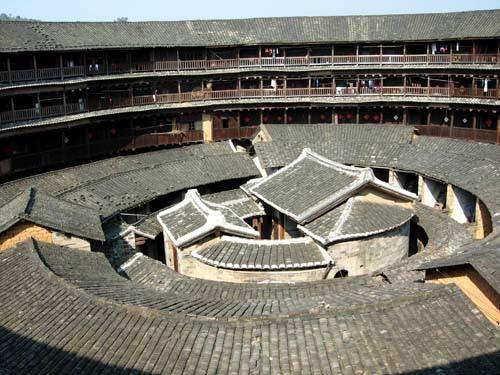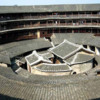Fujian Tulou (earth buildings) at Tianluokeng (Snail Pit village).
Source Wikipedia, taken by Gisling
From time to time a single photograph of a striking place or building will be the irresistible impetus for a trip to see the thing in person. In surrendering to these urges I've found I really cannot go wrong. My instincts seem to know when a thing is remarkable enough that any amount of bother will be worth the effort. I found this to be true again when a picture of a tulou (pronounced too'-low) in Fujian Province in Southern China sent me, literally, packing.
There are thousands of these tribal apartment blocks in the hills of Fujian, most of them hundreds of years old and still occupied by their builders, Hakka Minority people. They're made of mud bricks, 2 or 3 or 4 stories high, so their survival is an expression of their value to the people who live in and maintain these beautiful structures. One cannot really feel the monumental size of the some of them from a photograph. Standing outside the mud fortresses is awe-inspiring and I found myself feeling thrilled by the idea that these audacious and ancient buildings could exist today in their living grandeur and most people on the planet, myself included until recently, don't know of their existence. Some are now open to visitors.
Interior of Yuchanglou, its zigzag structure and part of ancestral hall
Photo courtesy Wikipedia. Taken by Gisling
The tulou, mostly round, are really more self-contained villages than just living quarters with ancestral halls and shops in the courtyards and ground floors and groups of residents gathering in twos and fours for tea and card games as one sees in towns throughout China where traditional life is often played out in the streets.
Yuchanglou, a 700 years old rotunda tulou in Yongding county.
Photo courtesy Wikipedia. Taken by Gisling
To reach the tulou I flew into Shanghai and next morning, after a change of airports, flew on to Xiamen (Sha'-min). I stayed for several days on Gulangu Island in the harbor to rest before my onward push to the tulou. The problem was, as few western tourists frequent the area and most of the tourists are Chinese, there really isn't an infrastructure in place for non-Chinese travelers to easily tour the area and English speakers are hard to come by. I eventually made my way to a very nice upscale Xiamen hotel where I was taken up to the travel office and offered a 1 or 2 day tour at a very reasonable price. I was warned that no one was likely to speak any English but if I could cope with that fact I was welcome to join a tour. So having come all this way I did not hesitate and signed up.
Earth building in Chengqi.
Photo courtesy Wikipedia. Taken by Bolobolo
I won't go on about the unexpected difficulties I encountered over the 2 days of my adventure. Suffice it to say I realized that I really hadn't had a clue, despite extensive previous travel, what it would be like to have absolutely no one who understood me. I had given up convenience for the sake of experiences in the past but never language absolutely. It was jarring to say the least although punctuated with unexpected moments of the kindness of strangers. And it was all worth it. I have the feeling I've beaten the crowd this time and may never have a similar experience in what's left of my travel life.
To see a photo gallery of my visit to the tulou, click here.
Read the prequel, 'Gulanyu Island', here.
To read more of PortMoresby’s contributions, click here.




Comments (12)